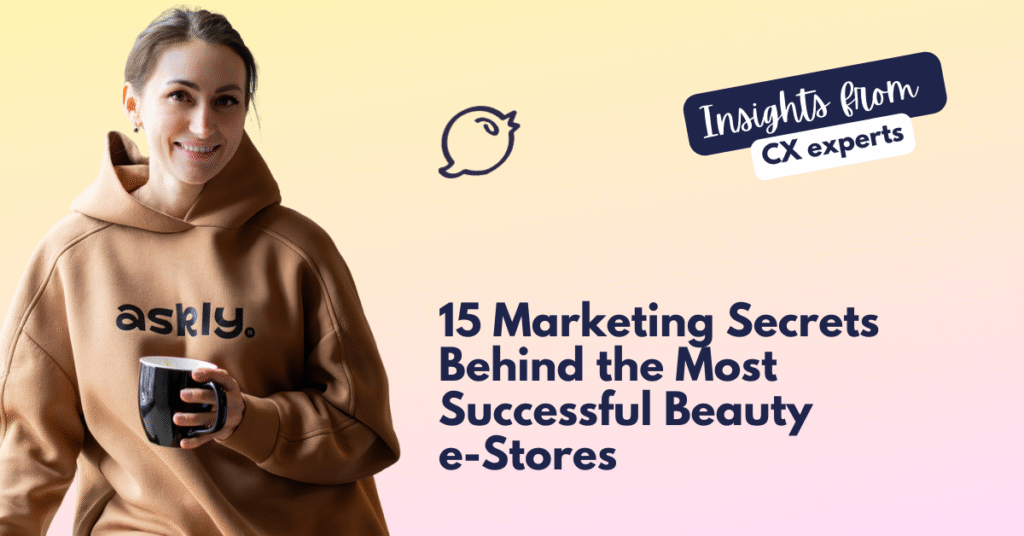15 Marketing Secrets Behind the Most Successful Beauty e-Stores

Sandra Roosna
Askly CEO & Founder

The beauty industry has always been built on aspiration, but selling beauty online is not as glamorous as it sounds. With endless competition and customers who are more skeptical than ever, running a successful beauty e-store today requires more than a pretty website and a few discounts.
Over the past decade, I’ve seen beauty brands rise from startups to household names. And while every founder believes their product is unique, the truth is harsh: without the right marketing engine, even the best products will fail online.
So, what makes the difference between a struggling e-store and a thriving one? Here are 15 well tested strategies I’ve seen successful beauty brands use to win in this hyper-competitive market.
1. Start With Trust: Online Beauty Still Lags Behind Offline
Here’s the inconvenient truth: less than 5% of all beauty sales happen online.
Why? Trust.
In a store, a customer can test a foundation shade or smell a fragrance. Online, they rely entirely on your ability to communicate quality, authenticity, and credibility. That’s why your marketing needs to do more than sell: it needs to prove you’re trustworthy from the very first impression.
TIP: One of the most low-budget ways to build trust is by showing up on social media channels like Instagram or Linkedin, with simple self-made videos of your products + link to your website. Be natural. Sound natural. Show up yourself.
2. Define Your Audience Beyond Demographics
Too many e-stores stop at “women, 18–35, into skincare.” That’s lazy marketing. Successful brands go deeper: they know what keeps their audience awake at night, the influencers they follow, and even the apps they use daily.
This isn’t just about better targeting in ads. It’s about speaking the customer’s language so your brand feels like it was designed just for them.
TIP: Make short interviews with your first customers. What and why they loved your product. What are their interests, hobbies…
3. Own Your USP Like Your Life Depends On It
In a saturated industry, your Unique Selling Point isn’t just a tagline. It’s survival. Whether it’s clean ingredients, cruelty-free testing, or premium luxury positioning, your USP should shape everything: product pages, ads, even customer support scripts.
When I see brands fail, it’s usually because they blend into the crowd with generic promises like “look younger” or “feel beautiful.” Successful e-stores are bold, specific, and different.
4. Design That Wins in 5 Seconds
Customers make up their minds in five seconds. In that window, your design must scream trust, quality, and innovation.
This doesn’t mean cluttering your site with flashy graphics. It means clean visuals, relatable lifestyle images, and packaging that feels aspirational yet attainable. Think of Sephora’s sleek minimalism or Glossier’s Instagram-friendly pastels.
TIP: Use tools like Canva or find freelance designers on Fiverr / Upwork. Usually 20-40 eur or usd/hour.
5. Customer Service That Sells
Here’s a stat that’s often overlooked: bad customer service kills conversion faster than bad design.
In beauty, where decisions are personal, shoppers expect real answers in real time. That’s why live chat isn’t optional anymore. Our clients at Askly often see 3x more completed purchases after adding conversational support. Because customers stop second-guessing and start checking out.
TIP: The winning formula: blend of AI efficiency and human empathy. Solutions like Askly enable probably the best CX on the market, while AI and humans work in synergy. Customers get quick answers, but customers needing human help are assigned to your team.
6. Product Descriptions That Sell With Emotion
Great beauty copy is not about listing ingredients — it’s about selling the feeling. Words like velvety, luminous, weightless spark emotion. Pair this with SEO optimization (keywords in URLs, titles, and descriptions) and you’ve got visibility and conversion.
TIP: Don’t forget social proof. A testimonial saying “this serum cleared my skin in two weeks” sells more than any ad campaign.
7. Make Checkout Frictionless
The checkout page is where great marketing dies if you’re not careful. Complex forms, limited payment options, or forced account creation drive abandonment.
The best beauty e-stores offer guest checkout, auto-fill, PayPal, Apple Pay, and Klarna. The easier you make it, the faster the sale closes.
TIP: Make sure your checkout is as short as possible. Every extra row of data means an abandoned cart. Ideally Apple Pay + zero data (you can get it from the provider).
8. Track What Actually Matters
If you don’t track it, you can’t improve it. The smartest brands obsess over KPIs like:
- Cart abandonment rate
- Average order value (AOV)
- Repeat purchase rate
- Customer lifetime value (CLTV)
Metrics aren’t just numbers. They’re signals that tell you what’s working, what’s broken, and where money is leaking.
9. Build an Online Presence Beyond Your Store
Beauty is a visual business, and Instagram is still the crown jewel. But don’t spread yourself thin. Master one channel, then expand.
I’ve seen small brands build cult followings just by posting authentic behind-the-scenes videos, answering skincare questions live, and showing the messy human side of running a beauty business. Perfection is out. Authenticity is in.
10. Leverage Influencers, but be Strategic
Not all influencers are created equal. Micro-influencers (5k–10k followers) often outperform celebrities because they feel real. Customers trust them more, and they’re far cheaper.
TIP: Tools like Promoty let you filter by audience, engagement, and location so you can find influencers who actually resonate with your buyers.
11. Subscription Models Build Loyalty
Beauty routines are repetitive. That’s why subscription models (starter kits, monthly refills) work so well. They reduce friction for customers and create recurring revenue for you.
The key is to make it feel personalized: like a friend who knows when you’re about to run out of moisturizer.
TIP: Offer for example 20% discount during checkout if a customer is subscribing to get the same product every 3 or 6 or 12 months. You will save lots of money on marketing and have predictable revenue.
12. Email Marketing Still Works (If Done Right)
Despite all the noise, email is still king. But spamming is dead.
Smart brands build opt-in sequences: welcome emails, personalized offers, testimonials, and abandoned cart nudges. Done right, email becomes your most profitable channel.
13. Reward Loyalty With More Than Discounts
Loyalty programs should feel like a club, not a gimmick. Exclusive access, surprise gifts, or early product drops create real emotional stickiness. Pair that with affiliate programs, and your customers become your best salespeople.
14. Show Your Values — Sustainability Sells
Today’s shoppers want transparency. Where do ingredients come from? Are they sustainable? Are they safe?
Brands that openly share this win long-term trust.
TIP: In beauty, you’re not just selling a cream or a lipstick, you’re selling self-confidence without compromise. Communicate it!
15. Consistency Wins the Marathon
The most successful brands don’t chase every trend. They commit to a consistent voice, product quality, and customer experience.
TIP: Consistency builds memory. And memory builds trust. Do not be afraid to share same post or same video 10-20 times with different taglines. Consistent testing makes you the winner.
One extra tip!
Success in beauty e-commerce comes from earning trust at scale: with design, customer service, storytelling, and consistency in place.
At Askly, we’ve seen firsthand how the right tools — especially in customer support — can make the difference between abandoned carts and loyal repeat buyers.
Sometimes, just one change can transform your store’s sales. We have worked with 1000+ beauty e-stores, big and small, and helped them grow sales and build trust with Askly software.
It is a simple plugin with massive AI-powered opportunities for customer communication. For example Askly AI Assistant replies to customers on your website, FB and IG DMs 24/7 in 30 languages. You can try it free (no obligations) here.
About the author

Sandra Roosna
Askly CEO & Founder
Sandra Roosna is the founder and CEO of Askly, a multilingual customer support platform for e-commerce. With a background in international business and experience from Y Combinator’s Startup School, she built Askly to help online stores improve customer communication across Europe.
Want more happy customers with a small team? Askly can easily help you achieve it.
Free trial. No obligations. Start growing you business tomorrow.
Recent posts
AI in customer service that finally works.
No costs. No obligations.
